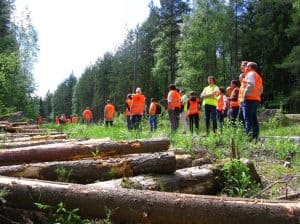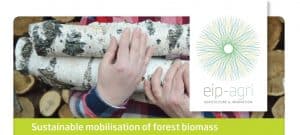In this NRN guest blog, Kieran Sullivan, part-time farmer and forester from Co. Waterford, and IT researcher with Waterford Institute of Technology, provides us with an invaluable insight into his own personal experience of participating in a European Innovation Partnership for Agricultural Productivity and Sustainability (EIP-AGRI) Focus Group exploring ‘Sustainable Mobilisation of Forest Biomass (SMFB)’. Kieran also gives us his thoughts and opinions on how an increase in demand for forestry biomass to produce energy can be achieved in a sustainable manner.
You wouldn’t think it, but roughly one-third of all land in Europe is covered by forests. This equates to over 215 million hectares, with an average increase of 700,000 hectares per annum. Europe is a big place however and its forestry is as diverse as the people and their cultures who live around these trees. Each forest type serves many interlinked functions. These include the production of logwood and biomass, habitats for wildlife, securing water management and soil fertility, storing carbon, and facilitating recreation, among others.
Various programmes and initiatives are focused on these different functions, and given the expected increase in demand for biomass, an EIP-AGRI Focus Group on Sustainable Mobilisation of Forest Biomass (SMFB) was established in 2016-17 to examine a number of specific aspects. EIP-AGRI Focus Groups are temporary groups of selected experts focusing on a specific subject, sharing knowledge and experience. The groups explore practical innovative solutions to problems or opportunities in the field, and draw on experiences derived from related useful projects.
The main driver for this demand for biomass is energy generation and since only 60-70% of the annual increment of EU forests is harvested, the potential exists to increase forest biomass mobilisation; in particular, amongst small private holdings and silvicultural practices such as pruning and complementary fellings (namely first thinnings).
A number of challenges had to be considered though, including sustainability, competitiveness of the forest-based industries, efficiency and economic viability, organisation and motivation of forest owners as well as new tools and technologies. In mobilising forest-based biomass, economic, environmental and social functions of forests have to be safeguarded.
Against this background, the main question addressed by the EIP-AGRI Focus Group on Sustainable Mobilisation of Forest Biomass (SMFB) was, “How to improve the sustainable mobilisation of biomass from our European forests?”
The Focus Group concentrated on mobilising different types of forest biomass for all potential markets and how to better interlink supply and demand, taking into account the current underused potential supply of forest biomass.
Process
Following an open call for selecting members, EIP-AGRI chosen 20 experts from around Europe. These included foresters, farmers, scientists, Government advisors, and environmentalists; together with a coordinator and two support members, the Group kick-started its work in Tampere, Finland, in June, 2016. The final result is a wide-ranging report, complete with insights and recommendations, and to feed into this, the Group centred on eight supporting documents (entitled, mini-papers):
- MP1: Multi-actors / Stakeholders involved in SMFB
- MP2: Forest Ownership types
- MP3: Forest Biomass Markets
- MP4: Decision support tools
- MP5: Harvesting technologies
- MP6: SMFB contribution to environmental issues
- MP7: Incentives for SMFB
- MP8: European map of the regional forest-based sector.
Over the course of a year the mini-papers were scoped out and developed, before a second and final workshop in Ljubljana, Slovenia, in February, 2017. At this point, the mini-papers were finalised and work began on incorporating them in the final report.
Main Findings
The Groups main findings centred on three complementary topics: (a) Market trends and new demand for forest biomass; (b) Tools to increase SMFB, such as digitisation, harvesting and transportation technologies, decision support tools and incentives; (c) Owners and other actors and potential climate/environment benefits.
The findings are explained in detail in the final report from the SMFB Group, which also contains 28 research themes and ideas to sustainably increase forest biomass. Of these, six activities were prioritised by the 20 experts:
- Evaluate impact of existing mobilisation incentives
- Extract lessons from existing regional forest ownership organisations
- Analyse future demand and supply, including new and traditional value chains
- Develop user-friendly information platforms and new map-based tools
- Investigate potential of new cross-regional value chains and production systems
- Identify and explore incentives for carbon sequestration through active forest management.
Author Biography
Kieran Sullivan is a part-time farmer and forester from Co. Waterford. He and his brother manage 13 hectares of alder and Sitka Spruce, as well as running a small sheep enterprise on their farm.
Kieran works off-farm as an IT researcher with Waterford Institute of Technology, where his interests include data analytics and ICT-AGRI. He has worked on EU research projects since 2008.
Kieran also writes a column for the Irish Farmers Journal and you can follow him on Twitter: @kieran_sullivan








